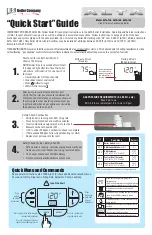
14
Connections & Terminations
For boilers connected to gas vents or chimneys, vent in
-
stallations shall be in accordance with Venting Require
-
ments of the National Fuel Gas Code, ANSI Z223.1-latest
revision, CSA-B149.1 and B149.2, and applicable provi
-
sions of the local building codes.
Provisions for combustion and ventilation air must be
in accordance with the National Fuel Gas Code, ANSI
Z223.1-latest revision, CSA-B149.1 and B149.2, or ap
-
plicable provisions of the local building code.
These boilers require a dedicated direct vent system. All
air for combustion is taken directly from outdoors through
the combustion air intake pipe. All flue products are dis
-
charged to the outdoors through the vent pipe. Insulate
lengths of combustion pipe in unconditioned areas.
See Figures 1 through 5 for combustion air and vent
1.
pipe roof and sidewall termination (roof termination is
preferred). Combustion air and vent pipes must termi
-
nate
together in same atmospheric pressure zone
as shown
. Construction through which vent and air
intake pipes may be installed is a maximum 24” and a
minimum ¼” thickness.
Combustion air and vent pipe fittings must conform
2.
to American National Standards Institute (ANSI) stan
-
dards and American Society for Testing and Materi
-
als (ASTM) standards D1784 (schedule-40 CPVC),
D1785 (schedule-40 PVC), D2665 (PVC-DWV),
D2241 (SDR-21 and SDR-26 PVC), D2661 (ABS-
DWV), or F628 (schedule-40 ABS). Pipe cement
and primer must conform to ASTM standards D2564
(PVC) or D2235 (ABS).
For Canadian installations all plastic venting material
3.
must be listed to ULC S636.
Do not use cellular core PVC for venting flue gas.
WARNING
!
Combustion air and vent pipe connections on boiler
4.
are 2” but must increase to 3”. Due to potential for flue
gas temperatures above 155°F, the first 30” of sup
-
plied vent pipe is CPVC while the remaining vent pipe
can be PVC. Any replacement of the first 30” of vent
pipe must be made with CPVC.
nOTE:
The exhaust transition from 2” pipe to
3” pipe must be made in a vertical run. Transi
-
tion pieces are not included.
(See Figure 8
for
details.)
Combustion and vent Piping Length
TABLE #4
maximum Allowable Temperatures
Of Typical non-metallic vet material
material
hdT
RTI
Standard
°f
°C
°f
°C
PVC
158
70
–
–
ASTM F 891 *
ASTM D2665 **
ASTM D1785 **
ASTM D2241 **
CPVC
210
100
–
–
ASTM D2846 **
ASTM F441 **
ASTM F442 **
ABS
180
82
–
–
ASTM D2661 ***
ASTM F628 ***
Radel-
A200
414
212
–
–
UL-1738
ULC S636
* Allowable temperatures based on Classifications covered
in ASTM D4396
[Deflection Temperatures under Load
(264psi) (1819 KPa)].
** Allowable temperatures based on Classifications covered
in ASTM D1784
[Deflection Temperatures under Load
(264psi) (1819 KPa)].
*** Allowable temperatures based on Classifications covered in
AsTM D3965
[Deflection Temperatures under Load(264psi)
(1819 KPa)]
.
3” Pipe min. venting
3” Pipe max. venting
15 ft. equivalent length
100 ft. equivalent length
The length of pipe is counted from the end of the supplied
2” CPVC pipe exiting the boiler. The termination is not
counted in the “Total Equipment Length.” The combustion
3 INCH INTAKE AND
EXHAUST TERMINATIONS
2” (50.8MM) CPVC
VENT PIPING
(FURNISHED &
REQUIRED)
FIELD INSTALL 2” BY 3”
TRANSITION IN THE
VERTICAL POSITION ONLY
(2 REQ’D, NOT FURNISHED)
2” (50.8MM) COMBUSTION AIR
INTAKE PIPING (FURNISHED)
Figure 8 - Combustion Air & Vent Piping
vIII - COmBUSTIOn AIR And vEnT PIPE















































